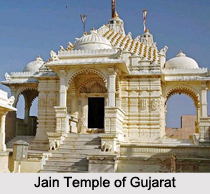 Jain Pilgrimages in western India are many which are of special importance to Jains because of associations with holy persons of the past. Some are the places where the enlightened ones left this world and achieved final liberation, some are places where celebrated religious events occurred, at others a famous temple or image draws the pilgrims. Pilgrimage to such places has long been popular.
Jain Pilgrimages in western India are many which are of special importance to Jains because of associations with holy persons of the past. Some are the places where the enlightened ones left this world and achieved final liberation, some are places where celebrated religious events occurred, at others a famous temple or image draws the pilgrims. Pilgrimage to such places has long been popular.
If the ancient Magadha state, modern Bihar, was the cradle of Jainism, the community is nowadays strongest in western India. Gujarat is particularly rich in Jain temples and places of pilgrimage. 700 years ago it is recorded that there were over 300 temples in western India, 200 of them in Gujarat.
Jain Pilgrimages in West Indian States
The Shwetambaras are dominant in western India and many sites are associated with this sect. Two places of pilgrimage in Gujarat, Girnar and Shatrunjaya, are so rich in temples and shrines that they have been described as temple cities.
In eastern Gujarat, Mount Girnar is associated with Lord Neminatha who achieved moksha there and is significant for both Shwetambara and Digambara sects. The Neminatha temple is in a rectangular courtyard surrounded by some 70 Tirthankara images. This is the largest temple but there are many others, including one founded by Vastupala in 1231 A.D. and dedicated to the 19th Tirthankara, Mallinatha.
Mount Shatrunjaya, near the village of Palitana in Gujarat, is considered the "King of Sacred Places" or "Tirthadhiraja" by the Shwetambaras. It is undoubtedly their most prestigious and famous tirtha. It is an ancient Jain pilgrimage as it was here that the first Tirthankara, Rishabha, as well as his chief follower, is said to have reached moksha. Many hundreds of temples and smaller shrines are contained within the 9 walled enclosures.
Unfortunately Shatrunjaya suffered much destruction during the Muslim conquests in the 14th and 15th centuries, but rebuilding took place after 1500 and in 1582 the Emperor Akbar formally conveyed to the Jains the land which they occupied here. Some of the larger temples are truly magnificent with their high sugar loaf shaped domes or spires, a typical feature of Jain temple architecture. From the late 17th century Shatrunjaya became more and more important.









